A Quantitative Evaluation Method of Anti-Sloughing Drilling Fluid Inhibition for Deep Mudstone
Abstract
1. Introduction
2. Methodology
2.1. Method of Hydration Characterization of Deep Mudstone
- (1)
- HPHT hydration experimental apparatus
- (2)
- Estimation of rock mechanical properties based on continuous scratch test
2.2. Method of Determining Correlation between Drilling Fluid Density and Matching Inhibition Index
- (1)
- Framework of wellbore stability model
- (2)
- Deterioration model of mudstone mechanical properties after hydration
- (3)
- Quantitative relation between drilling fluid density and matching inhibition index
2.3. Evaluation Procedure of Drilling Fluid Inhibition for Deep Mudstone
- (1)
- Obtaining the cross-correlation chart of drilling fluid density and inhibition index for deep mudstone
- Establishing the strength deterioration model of deep mudstone after hydration
- 2.
- Constructing the quantitative correlation chart
- (2)
- Evaluating inhibition property of drilling fluid
- Obtaining the required inhibition index of the tested drilling fluid based on the above correlation chart
- 2.
- Estimating the current inhibition index of the tested drilling fluid for deep mudstone
- 3.
- Judging the inhibition property of the tested drilling fluid
3. Application and Analysis
3.1. Detailed Design and Preparation for Evaluation
- (1)
- Hydration characterization of JDK mudstone
- (2)
- Establishment of the evaluation chart for JDK mudstone formation in the K block
- (3)
- Case study: Inhibition evaluations of drilling fluids taken from engineering field
3.2. Evaluation Chart of Drilling Fluid Inhibition Index for JDK Mudstone Formation
3.2.1. Hydration Characterization of Mudstone in JDK Formation
3.2.2. Quantitative Correlation Chart of Drilling Fluid Density and Required Inhibition Index for JDK Mudstone Formation
3.3. Case 1: Evaluation of Drilling Fluid in Well K 8-13 for JDK Mudstone
3.3.1. Inhibition Evaluations under Deep-Well Drilling Conditions and Ambient Conditions
3.3.2. Field Validation
3.4. Case 2: Evaluation of Drilling Fluid in Well K 9-3 for JDK Mudstone
3.4.1. Inhibition Evaluation under Deep-Well Drilling Conditions
3.4.2. Field Validation
4. Conclusions
- (1)
- In order to achieve the quantitative evaluation of the inhibition property of drilling fluid under deep-well drilling conditions, a new evaluation method that adopts cohesive strength of mudstone after hydration as the inhibition index of drilling fluid is proposed in this study. In this method, a newly designed HPHT hydration experiment apparatus (maximum surrounding temperature of 200 °C, maximum surrounding pressure of 60 MPa and flushing action of fluid) is developed to provide the real hydration environments in the process of drilling deep well. Additionally, a method of estimating cohesive strength of mudstone after hydration based on a scratch test is established to obtain the inhibition index of the tested drilling fluid. In addition, a cross-correlation between drilling fluid density and the matching inhibition index for deep mudstone, which is revealed by the mechanical–chemical wellbore stability model considering hydration characteristic of deep mudstone, is constructed as the quantitative evaluation criterion.
- (2)
- The comparison of inhibition evaluation results of drilling fluids under ambient conditions and natural well-drilling conditions illustrates that ignoring the natural surrounding environments in the process of inhibition evaluation of drilling fluid may cause overestimation of inhibition properties. Therefore, it is very necessary and meaningful to propose a new inhibition evaluation method of drilling fluid under real well-drilling conditions for wellbore stability in deep mudstone.
- (3)
- The evaluation results of drilling fluids taken from the well K 8-13 and well K 9-3, which are provided by the proposed evaluation method, are in line with the field data. In some ways, the developed quantitative evaluation method of inhibition property of drilling fluid for deep mudstone is validated.
- (4)
- The developed quantitative method can consider the coupling actions of mechanical and chemical actions of drilling fluid and provide strong support for field engineers to sustain wellbore stability through adjustments of drilling fluid density and inhibition properties.
- (5)
- In order to achieve the widespread application of the proposed method in drilling engineering field, our research group is trying to make a miniaturized experimental evaluation platform and standardize the evaluation procedure.
Author Contributions
Funding
Institutional Review Board Statement
Informed Consent Statement
Data Availability Statement
Conflicts of Interest
References
- Aston, M.S.; Elliot, G.P. Water-based glycol drilling muds: Shale inhibition mechanisms. In Proceedings of the European Petroleum Conference, London, UK, 25–27 October 1994. [Google Scholar]
- Patel, A.; Stamatakis, E.; Young, S.; Cliffe, S. Designing for the future—A review of the design, development and testing of a novel, inhibitive water-based drilling fluid. In Proceedings of the AADE 2002 Technical Conference, Houston, TX, USA, 2–3 April 2002. [Google Scholar]
- Ghasemi, M.; Moslemizadeh, A.; Shahbazi, K.; Mohammadzadeh, O.; Zendehboudi, S.; Jafari, S. Primary evaluation of a natural surfactant for inhibiting clay swelling. J. Pet. Sci. Eng. 2019, 178, 878–891. [Google Scholar] [CrossRef]
- Qiu, Z.; Zhong, H.; Huang, W.; Wan, J.; Xu, J. A new method for evaluation the properties of high-performance drilling fluids. Drill. Fluid Completion Fluid 2009, 26, 58–59. [Google Scholar]
- Al-Arfaj, M.; Amanullah, M.; Sultan, A. Chemical and mechanical aspects of wellbore stability in shale formations: A literature review. In Proceedings of the Abu Dhabi International Petroleum Exhibition and Conference, Abu Dhabi, United Arab Emirates, 10–13 November 2014. [Google Scholar]
- Stephens, M.; Gomez, S.; Churan, M. Laboratory methods to assess shale reactivity with drilling fluids. In Proceedings of the 2009 National Technical Conference and Exhibition, New Orleans, LA, USA, 12–14 April 2009. [Google Scholar]
- Salles, F.; Bildstein, O.; Douillard, J.M.; Jullien, M.; Raynal, J.; Van, D.H. On the cation dependence of interlamellar and interparticular water and swelling in smectite clays. Langmuir 2010, 26, 5028–5037. [Google Scholar] [CrossRef]
- Huang, W.A.; Li, X.; Qiu, Z.S.; Jia, J.H.; Wang, Y.; Li, X. Inhibiting the surface hydration of shale formation using preferred surfactant compound of polyamine and twelve alkyl two hydroxyethyl amine oxide for drilling. J. Pet. Sci. Eng. 2017, 159, 791–798. [Google Scholar] [CrossRef]
- Patel, A.; Stamatakis, E.; Young, S.; Friedheim, J. Advances in inhibitive water-based drilling fluids—Can they replace oil-based muds? In Proceedings of the 2007 SPE International Symposium on Oilfield Chemistry, Houston, TX, USA, 28 February–2 March 2007. [Google Scholar]
- Zhong, H.Y.; Qiu, Z.S.; Sun, D.; Zhang, D.M.; Huang, W.A. Inhibitive properties comparison of different polyetheramines in water-based drilling fluid. J. Pet. Sci. Eng. 2015, 26, 99–107. [Google Scholar] [CrossRef]
- Chen, G.; Yan, J.; Li, L.; Zhang, J.; Gu, X.; Song, H. Preparation and performance of amine-tartaric salt as potential clay swelling inhibitor. Appl. Clay Sci. 2017, 138, 12–16. [Google Scholar] [CrossRef]
- Hou, J.; Liu, Y.G.; Song, G.S.; Song, T.; Yan, J.; Zhao, X.Z. Synthesis and application of a new high temperature high performance salt resistant shale inhibitor. Drill. Fluid Completion Fluid 2016, 33, 22–27. [Google Scholar]
- Dobson, J.W.; Harrison, J.C.; Hale, A.H.; Bernardi, L.A.; Kielty, J.M.; Albrecht, M.S.; Bruner, S.D. Laboratory development and field application of a novel water-based drill-in fluid for geopressured horizontal wells. In Proceedings of the SPE Technology Conference and Exhibition, Denver, CO, USA, 6–9 October 1998. [Google Scholar]
- National Energy Administration. Evaluating Method of Shale Inhibition for Drilling Fluids (Energy Sector Standard of the People’s Republic of China): NB/T 10121-2018; Petroleum Industry Press: Beijing, China, 2018. [Google Scholar]
- Zhong, H.Y.; Qiu, Z.S.; Huang, W.A.; Cao, J. Shale inhibitive properties of polyether diamine in water-based drilling fluid. J. Pet. Sci. Eng. 2011, 78, 510–515. [Google Scholar] [CrossRef]
- Li, H.K.; Tian, R.J.; Luo, J.S.; Zhang, X.L.; Liu, G.; Wang, N. New method for quantitative evaluation of amine inhibitor used in drilling fluid. Drill. Fluid Completion Fluid 2012, 29, 51–53. [Google Scholar]
- Yin, Z.W.; Geng, D.S.; Wang, X.N. Evaluation method on inhibiting mud shale hydration and swelling in mud filtrate. Drill. Fluid Completion Fluid 2013, 30, 44–47. [Google Scholar]
- Zhong, H.Y.; Sun, D.; Qiu, Z.S.; Huang, W.A.; Liu, Y.F. Evaluation and analysis on the inhibitive capacity of a new naphthenic amine. Drill. Fluid Completion Fluid 2014, 31, 1–5. [Google Scholar]
- Shadizadeh, S.; Moslemizadeh, A.; Dezaki, A.S. A novel nonionic surfactant for inhibiting shale hydration. Appl. Clay Sci. 2015, 118, 74–86. [Google Scholar] [CrossRef]
- Fan, Z.X.; Gao, J.P.; Guo, D.R. Comprehensive evaluation of mud shale hydration. Pet. Drill. Tech. 1999, 27, 26–27. [Google Scholar]
- Luo, C.Z.; Zeng, F.D.; Xiang, X.J.; Xie, Q.P.; Lai, Y.L. Laboratory study on inhibitive evaluation method of drilling fluid and its treating agent. Pet. Drill. Tech. 2000, 28, 35–36. [Google Scholar]
- Huang, L.J.; Luo, X.S. Study on the testing method of polymer inhibit evaluation by capillary suction time tester. Drill. Fluid Completion Fluid 1995, 12, 44–47. [Google Scholar]
- Luo, Z.H.; Wang, L.X.; Yu, P.Z.; Chen, Z.X. Experimental study on the application of an ionic liquid as a shale inhibitor and inhibitive mechanism. Appl. Clay Sci. 2017, 150, 267–274. [Google Scholar] [CrossRef]
- Gholami, R.; Elochukwu, H.; Fakhari, N.; Sarmadivaleh, M. A review on borehole instability in active shale formations: Interactions, mechanisms and inhibitors. Earth-Sci. Rev. 2018, 177, 2–13. [Google Scholar] [CrossRef]
- Zhong, H.Y.; Huang, W.A.; Qiu, Z.S.; Wang, M.M.; Liu, Y.Q.; Jin, H.F.; Liu, C.Z. Experimental study of inhibition comparison between polyamine and formats. Fault-Block Oil Gas Field 2012, 19, 508–512. [Google Scholar]
- Lu, Y.; Chen, M.; Jin, Y.; Teng, X.; Wu, W.; Liu, X. Experimental study of strength properties of deep mudstone under drilling fluid soaking. Chin. J. Rock Mech. Eng. 2012, 31, 1400–1405. [Google Scholar]
- Mohamed, A.K.; Benaafi, M.; Elkatany, S.M.; Bageri, B.S. Effect of high-density water-based drilling fluid on the mechanical properties of the drilled formation in horizontal wells. In Proceedings of the 53rd US Rock Mechanics/Geomechanics Symposium, New York, NY, USA, 23–26 June 2019. [Google Scholar]
- Gamal, H.; Elkatany, S.; Adebayo, A.; Bageri, B. Effect of exposure time on the compressive strength and formation damage of sandstone while drilling horizontal wells. J. Pet. Sci. Eng. 2020, 195, 107590. [Google Scholar] [CrossRef]
- Taherdangkoo, R.; Tatomir, A.; Anighoro, T.; Sauter, M. Modeling fate and transport of hydraulic fracturing fluid in the presence of abandoned wells. J. Contam. Hydrol. 2019, 221, 58–68. [Google Scholar] [CrossRef] [PubMed]
- Bo, K.H.; Jin, Y.; Lu, Y.H.; Wang, K.; Zhu, J.Z. An approach for studying effect of hydration under deep well drilling conditions on strength properties of mudstone. In Proceedings of the 55th US Rock Mechanics/Geomechanics Symposium, Houston, TX, USA, 20–23 June 2021. [Google Scholar]
- Detournay, E.; Defourny, P. A phenomenological model for the drilling action of drag bits. Int. J. Rock Mech. Min. Sci. Geomech. Abstr. 1992, 29, 13–23. [Google Scholar] [CrossRef]
- Richard, T.; Dagrain, F.; Poyol, E.; Detournay, E. Rock strength determination from scratch tests. Eng. Geol. 2012, 147, 91–100. [Google Scholar] [CrossRef]
- Rostamsowlat, I.; Richard, T.; Evans, B. An experimental study of the effect of back rake angle in rock cutting. Int. J. Rock Mech. Min. Sci. 2018, 107, 224–232. [Google Scholar] [CrossRef]
- Bradley, W.B. Failure of inclined boreholes. J. Energy Resour. Technol. 1979, 101, 232–239. [Google Scholar] [CrossRef]
- Chen, M.; Jin, Y.; Zhang, G.Q. Petroleum Related Rock Mechanics; Science Press: Beijing, China, 2008; pp. 58–61. [Google Scholar]
- Jin, Y.; Yuan, J.; Hou, B.; Chen, M.; Lu, Y.; Li, S.; Zou, Z. Analysis of the vertical borehole stability in anisotropic rock formations. J. Pet. Explor. Prod. Technol. 2012, 2, 197–207. [Google Scholar] [CrossRef][Green Version]
- Liu, M.; Jin, Y.; Lu, Y.; Chen, M.; Wen, X. Oil-based critical mud weight window analyses in HTHP fractured tight formation. J. Pet. Sci. Eng. 2015, 135, 750–764. [Google Scholar] [CrossRef]
- Yew, C.H.; Chenevert, M.E.; Wang, C.L.; Osisanya, S.O. Wellbore stress distribution produced by moisture adsorption. SPE Drill. Eng. 1990, 5, 311–316. [Google Scholar] [CrossRef]
- Huang, R.Z.; Chen, M.; Deng, J.G.; Wang, K.P.; Chen, Z.X. Study on shale stability of wellbore by mechanics coupling with chemistry method. Drill. Fluid Completion Fluid 1995, 12, 15–21. [Google Scholar]
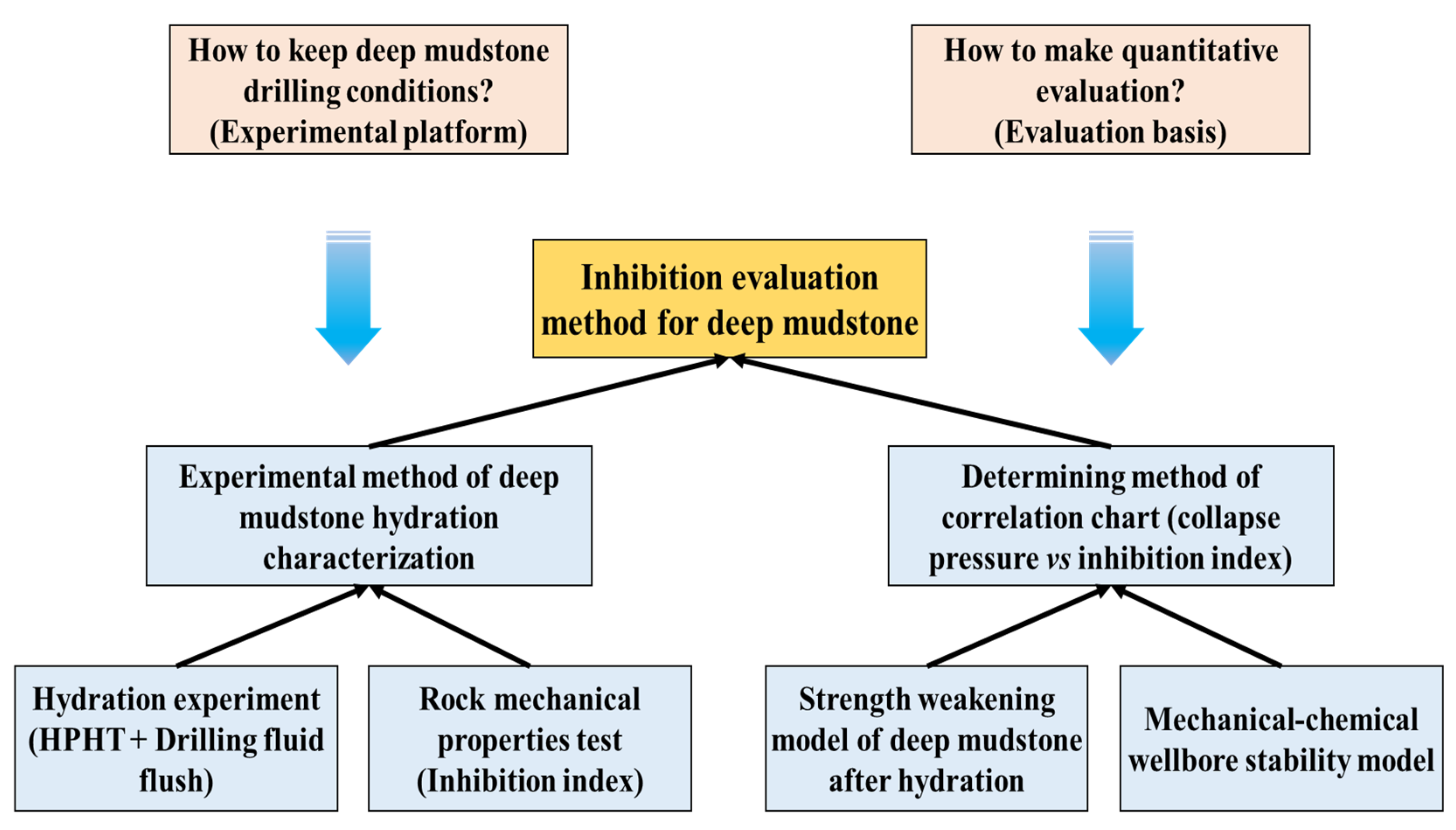

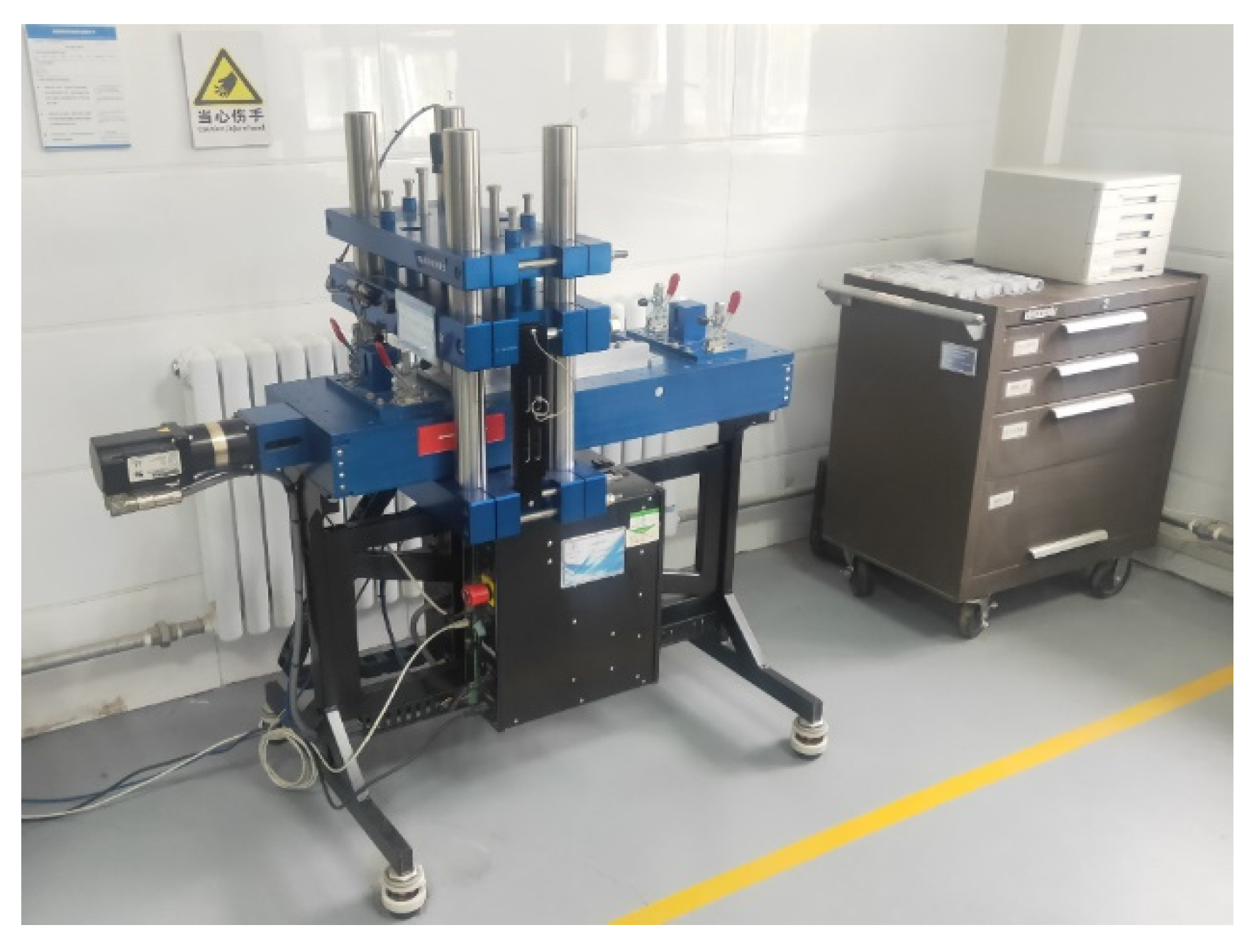
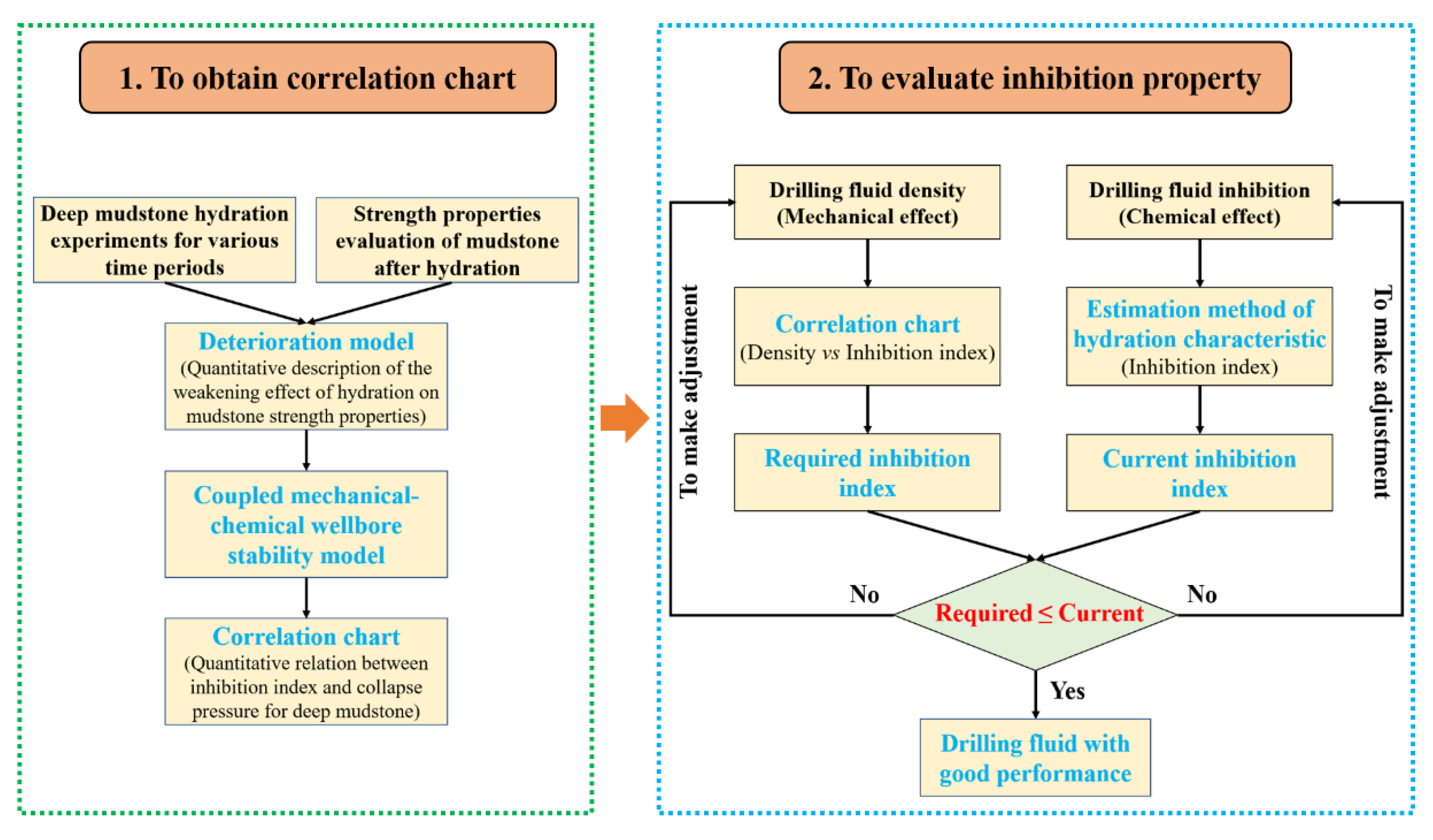

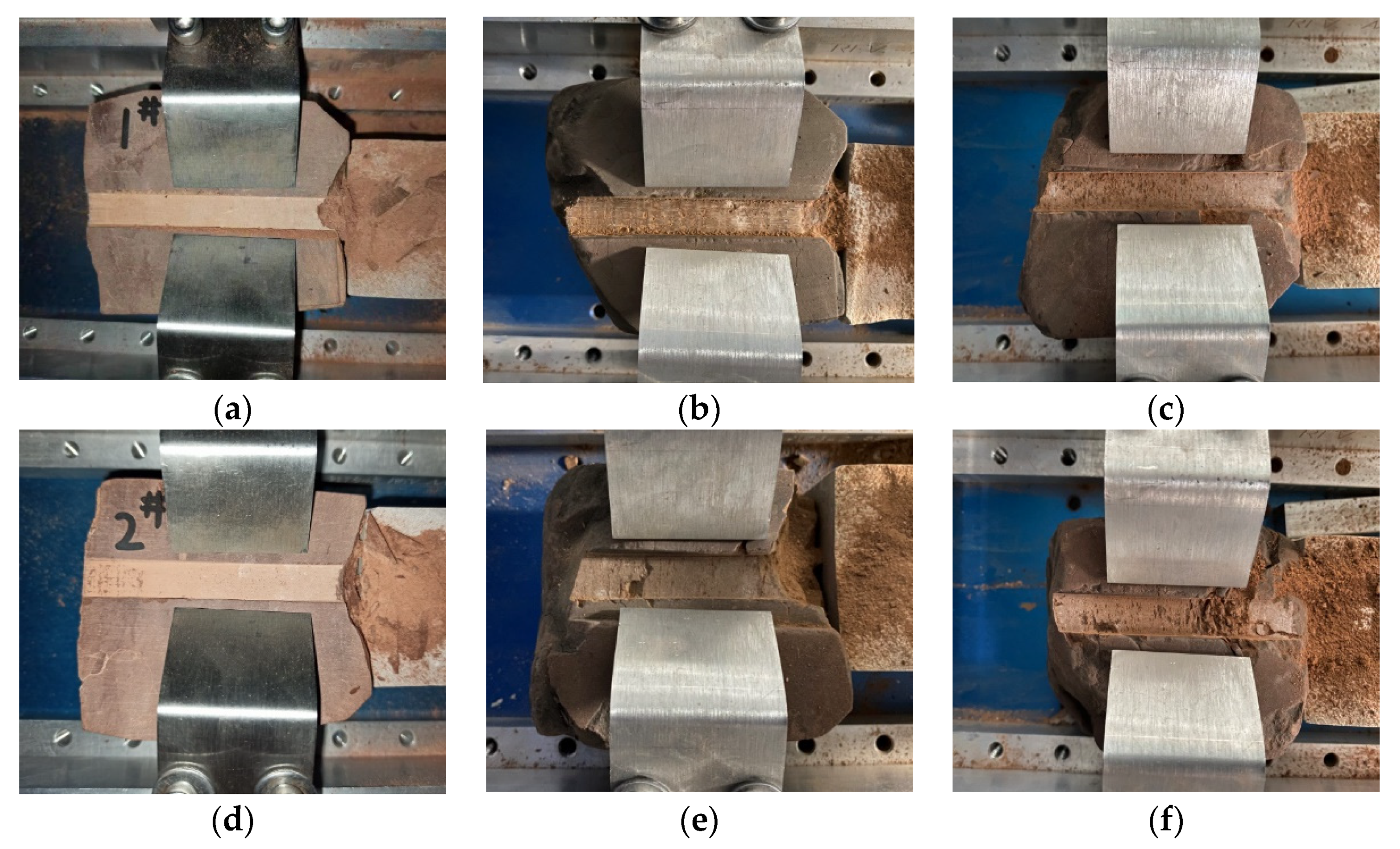
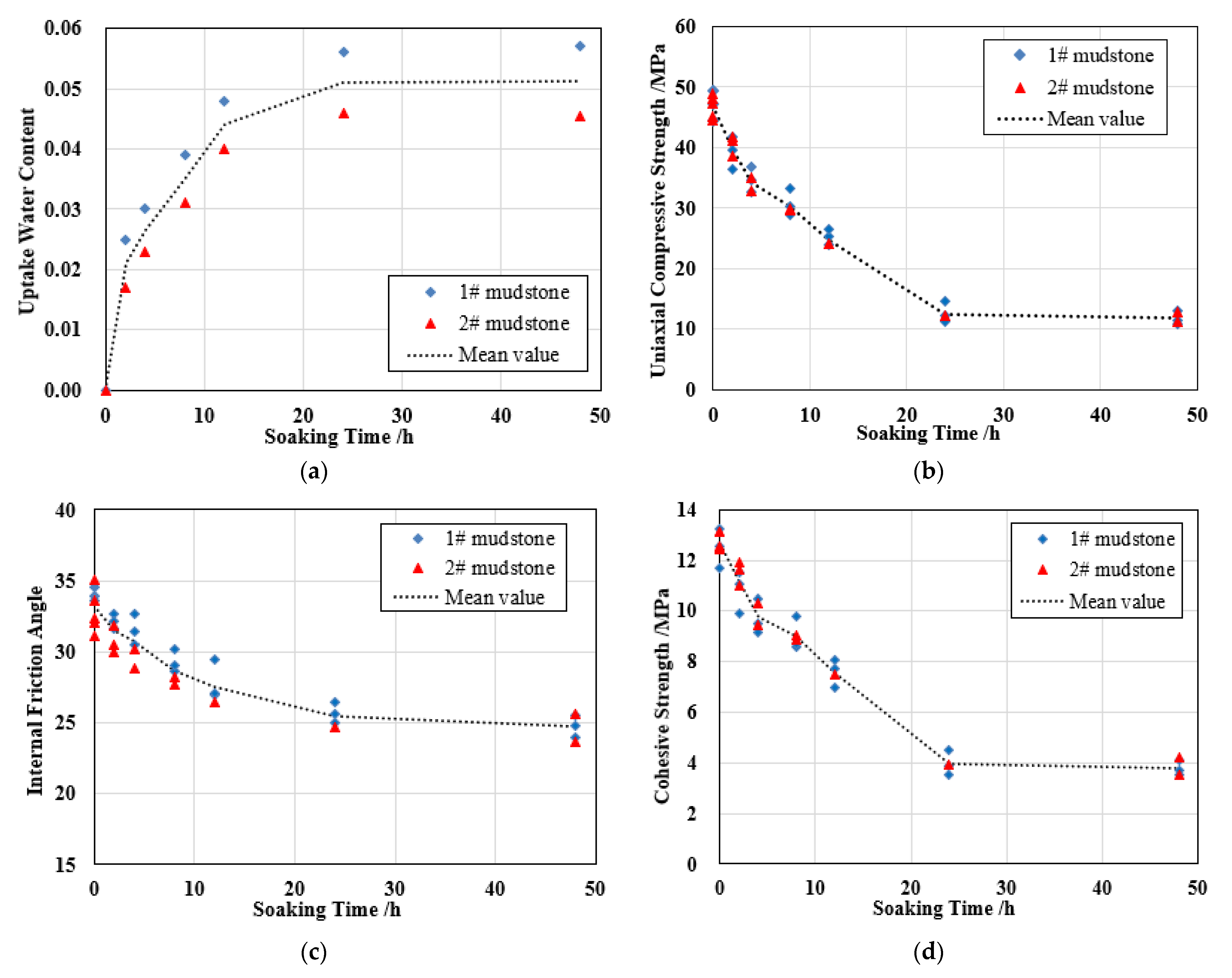
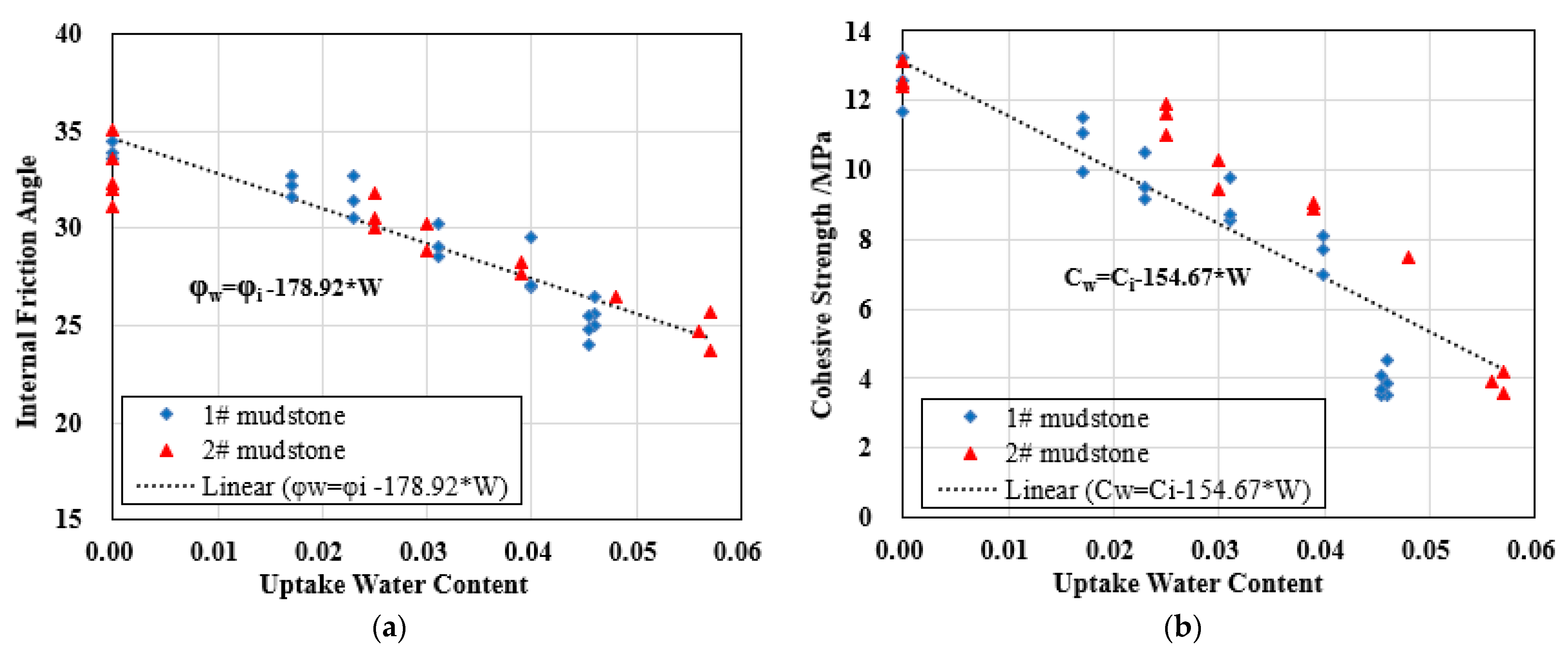
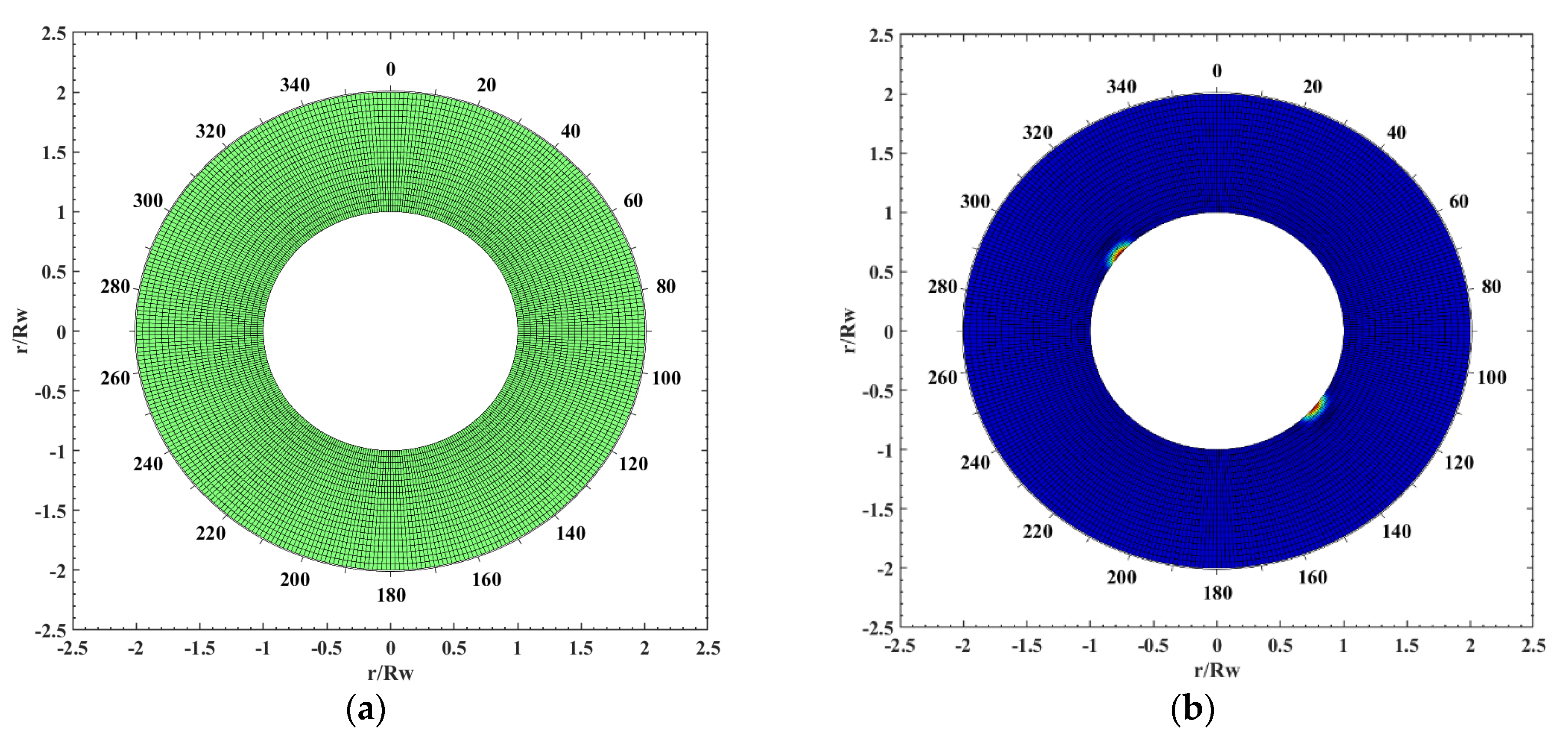

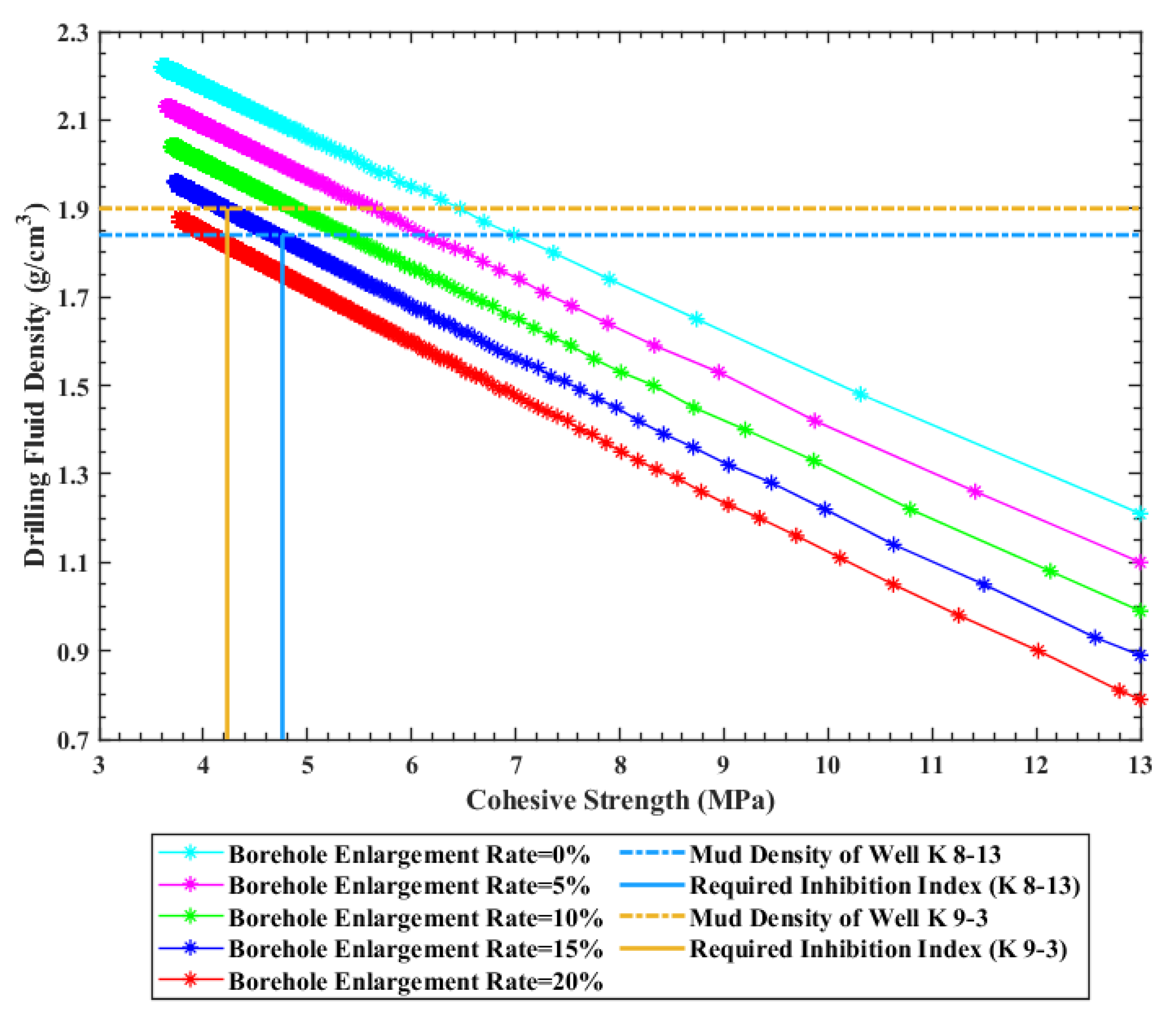

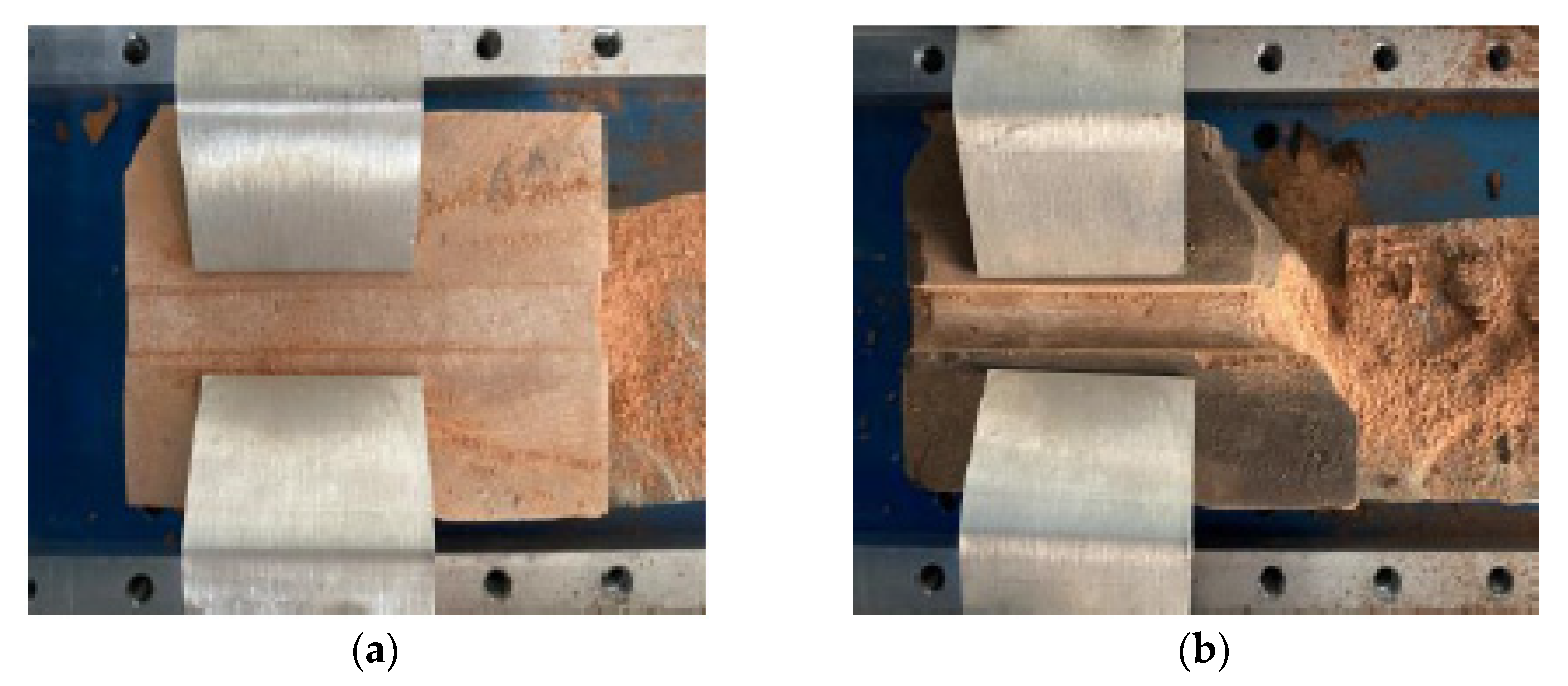
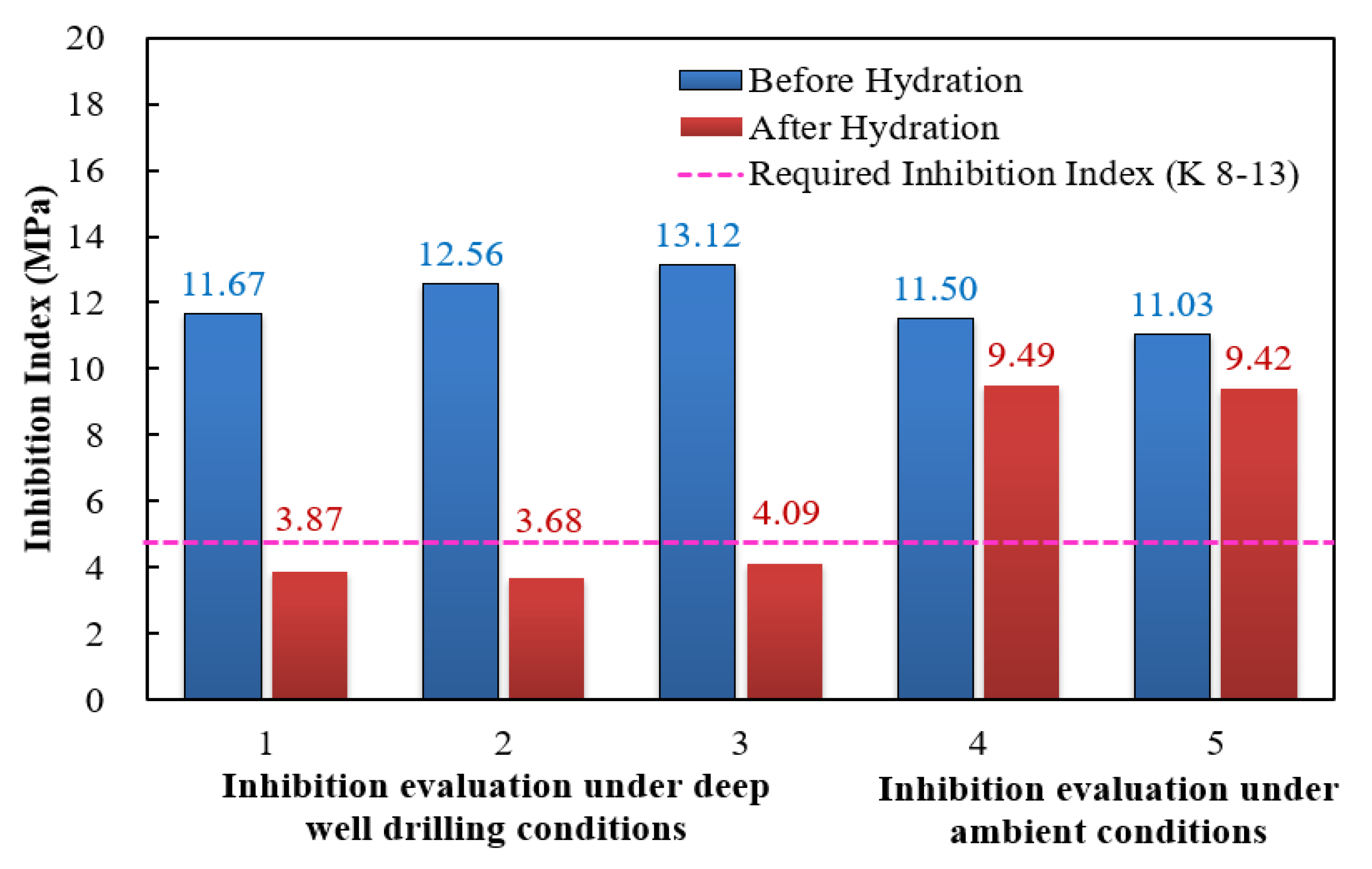
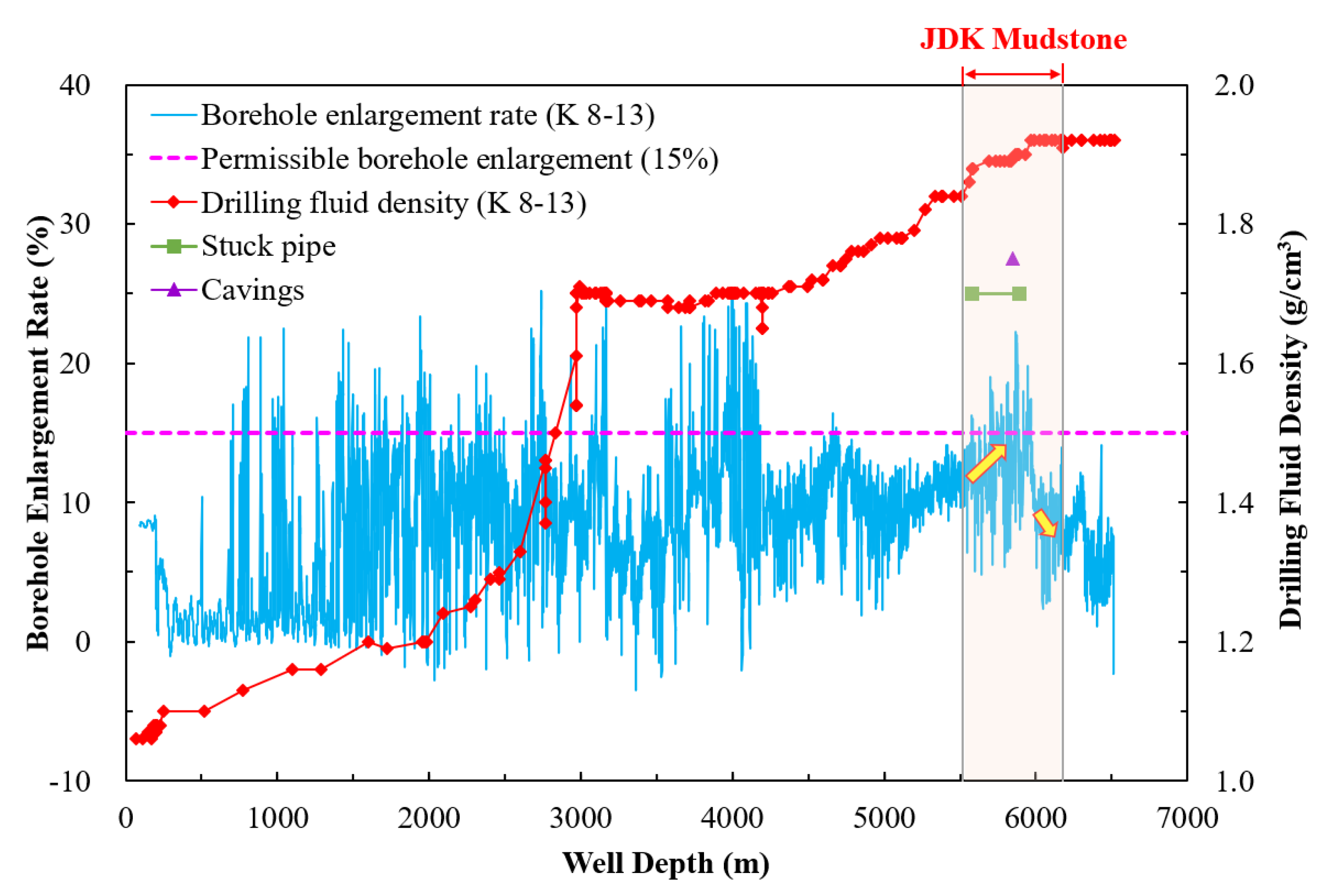
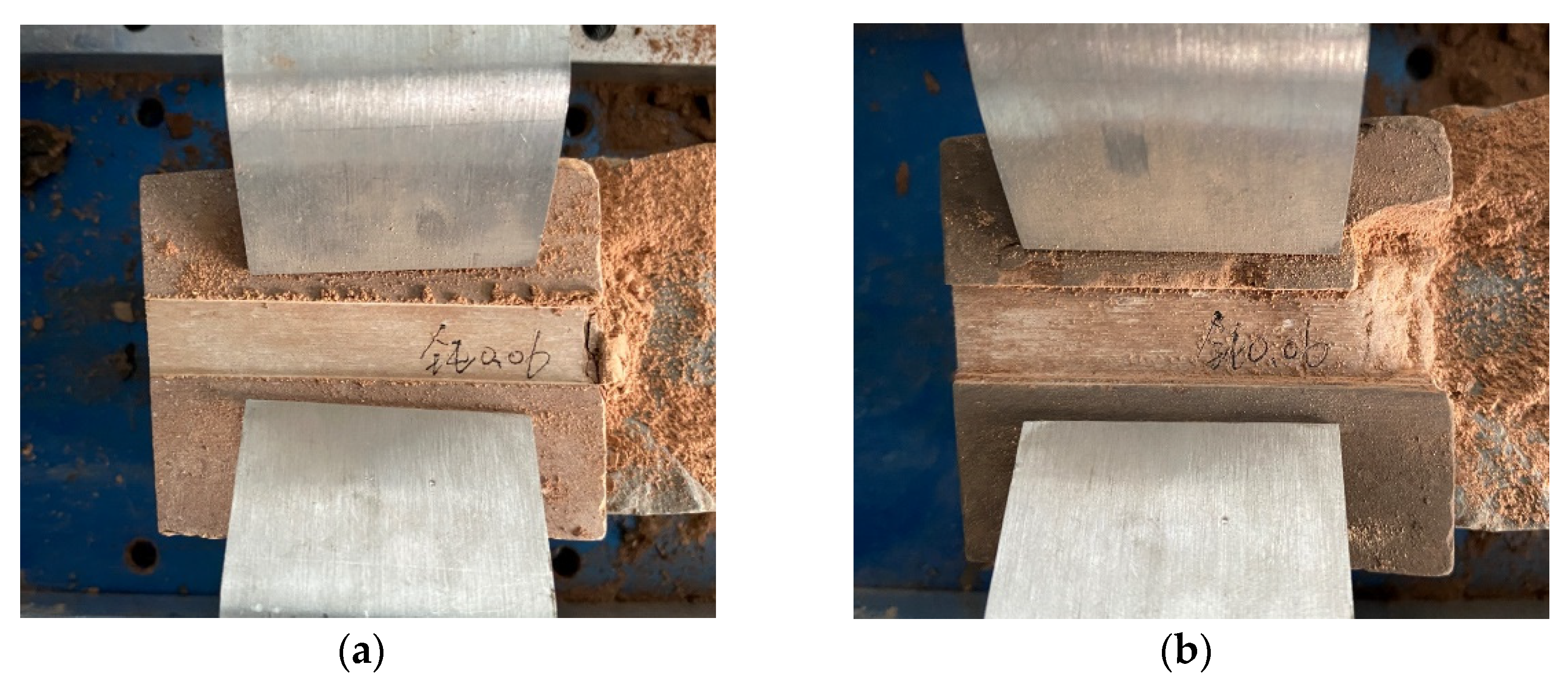
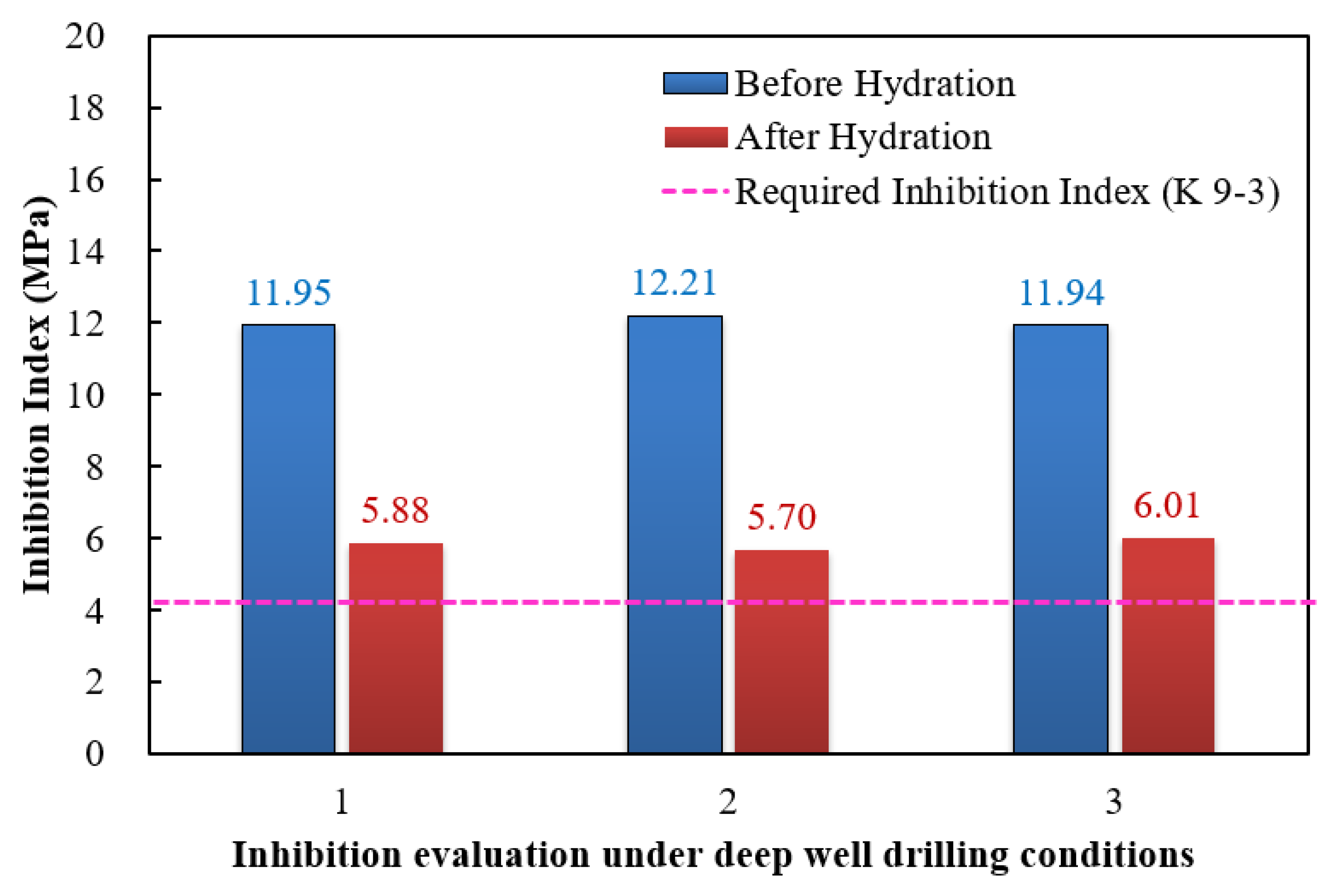
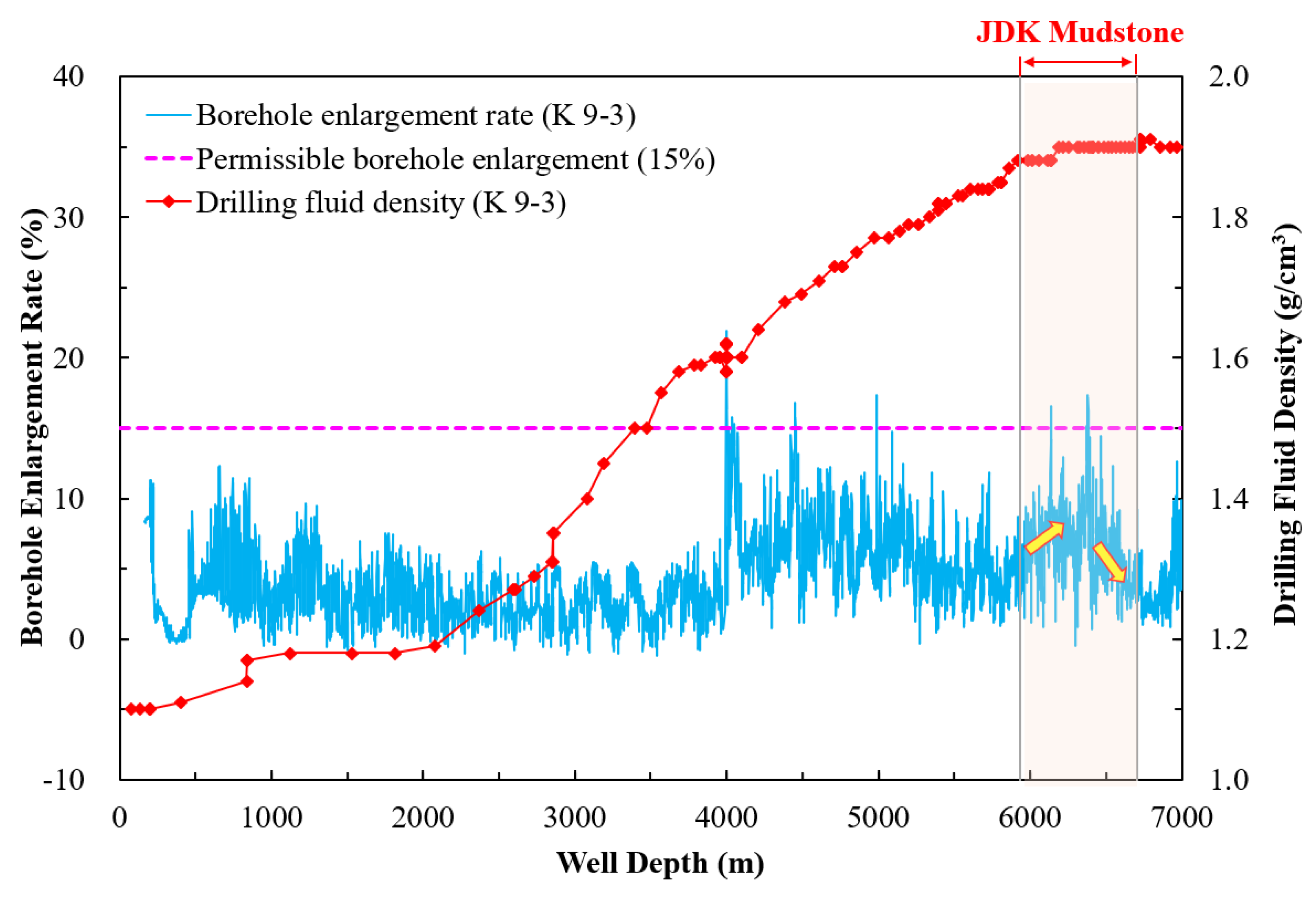
| Order | Method | Experimental Apparatus | Evaluation Condition | Tested Sample | Applicability Analysis | Reference | ||
|---|---|---|---|---|---|---|---|---|
| Temperature | Pressure | Solid Medium | Liquid Medium | |||||
| 1 | Rheological evaluation | ZNN-D6 viscometer | Ambient temperature | Ambient pressure | Bentonite powder | Inhibitor solution | Qualitative evaluation | [15] |
| 2 | Hot rolling dispersion test | Roller oven | ~160 °C | Ambient pressure | Shale cuttings | Inhibitor solution | Qualitative evaluation (dispersion tendency) | [1,2,3] |
| 3 | Slake durability evaluation | Slake durability test instrument | Ambient temperature | Ambient pressure | Shale cuttings | Inhibitor solution | Qualitative evaluation (dispersion test with more abrasive condition) | [2,4,5] |
| 4 | Swelling test | NP-02A shale expansion apparatus | ~180 °C | ~10 MPa | Shale/bentonite pellet | Inhibitor solution | Qualitative evaluation (swelling tendency) | [5,6,7,8] |
| 5 | Bulk hardness test | Bulk hardness tester | Hot rolling | Ambient pressure | Shale cuttings | Inhibitor solution | Qualitative evaluation (mechanical property) | [4,9] |
| 6 | High-speed centrifugation | Centrifuge | Ambient temperature | Ambient pressure | Bentonite powder | Inhibitor solution | Qualitative evaluation (swelling tendency); Poor performance to amine inhibitors | [16,17] |
| 7 | Flocculation experiment | - | Ambient temperature | Ambient pressure | Bentonite powder | Inhibitor solution | Qualitative evaluation (swelling tendency) | [18,19] |
| 8 | Water separating ratio test | Roller oven | Hot rolling | Ambient pressure | Bentonite powder | Inhibitor solution | Qualitative evaluation (swelling tendency) | [16] |
| 9 | Water adsorption test | - | Ambient temperature | Ambient pressure | Modified bentonite with inhibitors | Deionized water | Qualitative evaluation (swelling tendency) | [10] |
| 10 | Specific surface area test with methylene blue | 751 spectrophotometer | Ambient temperature | Ambient pressure | Bentonite/cutting powder | Inhibitor solution | Qualitative evaluation (swelling tendency) | [20,21] |
| 11 | Mud ball immersing test | - | Ambient temperature | Ambient pressure | Bentonite | Inhibitor solution | Qualitative evaluation (dispersion tendency) | [3,11] |
| 12 | Capillary suction time test | Capillary suction time tester | Ambient temperature | Ambient pressure | Shale powder | Inhibitor solution | Qualitative evaluation; Simple operation; Poor repeatability. | [22,23,24] |
| 13 | Particle size distribution test | Laser particle size analyzer | Ambient temperature | Ambient pressure | Bentonite | Inhibitor solution | Qualitative evaluation (dispersion tendency) | [11,12] |
| 14 | Accretion test | Roller oven + steel bar | ~160 °C | Ambient pressure | Shale cuttings | Inhibitor solution | Qualitative evaluation | [2,9] |
| 15 | Zeta potential test | Zeta sizer 3000 electric potential and granularity meter | Ambient temperature | Ambient pressure | Bentonite/shale powder | Inhibitor solution | Qualitative evaluation (dispersion tendency) | [8,25] |
| 16 | X-ray diffraction analysis | X-ray diffractometer | Ambient temperature | Ambient pressure | Bentonite/shale powder | Inhibitor solution | Qualitative evaluation (swelling tendency) | [15,25] |
| 17 | Shale stability index test | Penetrometer | ~160 °C | Ambient pressure | Shale/bentonite pellet | Inhibitor solution | Qualitative evaluation (mechanical property) | [8,13] |
| 18 | Cohesive strength test | Triaxial compressive test system | Ambient temperature | Ambient pressure | Cylindrical shale/mudstone | Inhibitor solution | Qualitative evaluation (mechanical property); Complicated and destructive test | [14] |
| Parameters | Unit | Value | Parameters | Unit | Value |
|---|---|---|---|---|---|
| Mudstone porosity | - | 6% | Drilling fluid density | g/cm3 | Variable |
| Overburden stress | MPa | 132 | Azimuth angle of borehole | ° | N150E |
| Maximum horizontal principle stress | MPa | 180 | Inclination angle of borehole | ° | 2 |
| Minimum horizontal principle stress | MPa | 108 | Azimuth angle of minimum horizontal stress | ° | N100E |
| Initial cohesive strength | MPa | 13 | Initial Poisson’s ratio | - | 0.23 |
| Initial internal friction angle | ° | 31 | Effective stress coefficient | - | 0.8 |
Publisher’s Note: MDPI stays neutral with regard to jurisdictional claims in published maps and institutional affiliations. |
© 2022 by the authors. Licensee MDPI, Basel, Switzerland. This article is an open access article distributed under the terms and conditions of the Creative Commons Attribution (CC BY) license (https://creativecommons.org/licenses/by/4.0/).
Share and Cite
Bo, K.; Jin, Y.; Lu, Y.; Liu, H.; Zhu, J. A Quantitative Evaluation Method of Anti-Sloughing Drilling Fluid Inhibition for Deep Mudstone. Energies 2022, 15, 1226. https://doi.org/10.3390/en15031226
Bo K, Jin Y, Lu Y, Liu H, Zhu J. A Quantitative Evaluation Method of Anti-Sloughing Drilling Fluid Inhibition for Deep Mudstone. Energies. 2022; 15(3):1226. https://doi.org/10.3390/en15031226
Chicago/Turabian StyleBo, Kehao, Yan Jin, Yunhu Lu, Hongtao Liu, and Jinzhi Zhu. 2022. "A Quantitative Evaluation Method of Anti-Sloughing Drilling Fluid Inhibition for Deep Mudstone" Energies 15, no. 3: 1226. https://doi.org/10.3390/en15031226
APA StyleBo, K., Jin, Y., Lu, Y., Liu, H., & Zhu, J. (2022). A Quantitative Evaluation Method of Anti-Sloughing Drilling Fluid Inhibition for Deep Mudstone. Energies, 15(3), 1226. https://doi.org/10.3390/en15031226





